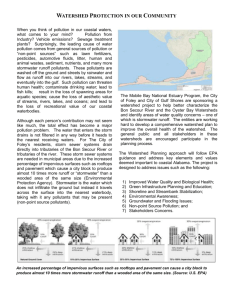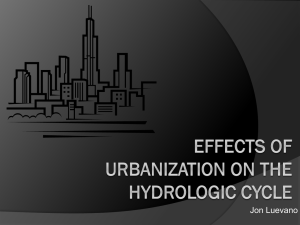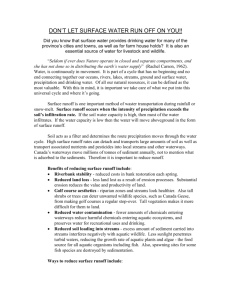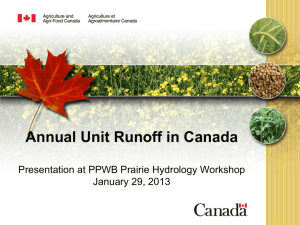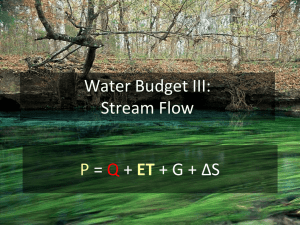abs322_article
advertisement
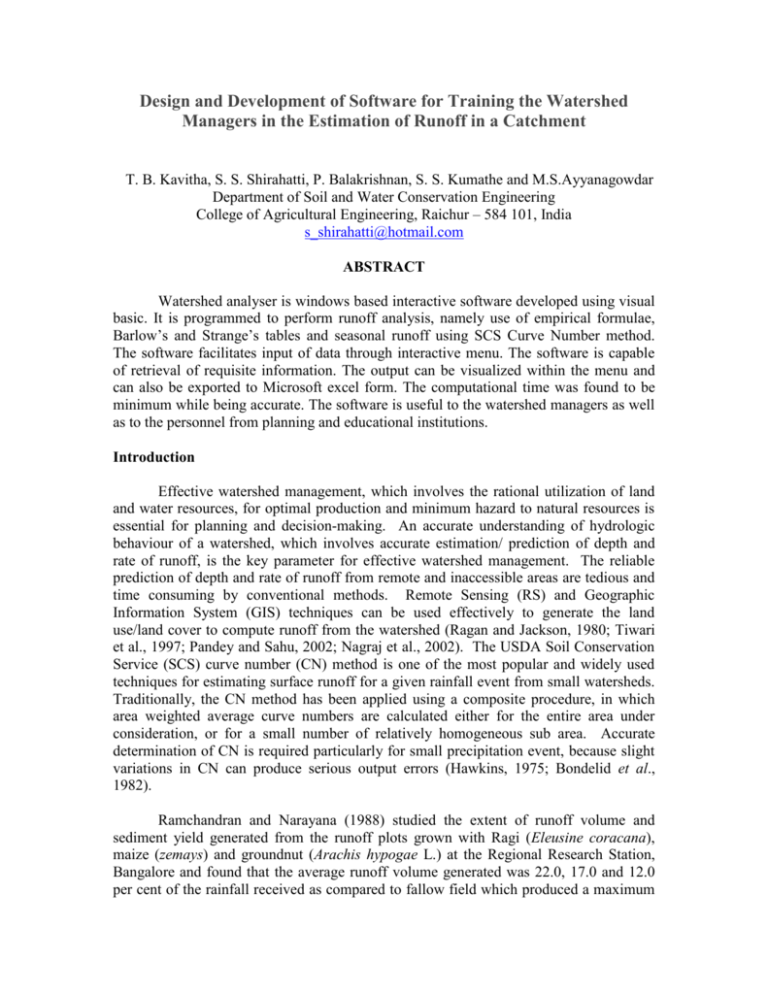
Design and Development of Software for Training the Watershed Managers in the Estimation of Runoff in a Catchment T. B. Kavitha, S. S. Shirahatti, P. Balakrishnan, S. S. Kumathe and M.S.Ayyanagowdar Department of Soil and Water Conservation Engineering College of Agricultural Engineering, Raichur – 584 101, India s_shirahatti@hotmail.com ABSTRACT Watershed analyser is windows based interactive software developed using visual basic. It is programmed to perform runoff analysis, namely use of empirical formulae, Barlow’s and Strange’s tables and seasonal runoff using SCS Curve Number method. The software facilitates input of data through interactive menu. The software is capable of retrieval of requisite information. The output can be visualized within the menu and can also be exported to Microsoft excel form. The computational time was found to be minimum while being accurate. The software is useful to the watershed managers as well as to the personnel from planning and educational institutions. Introduction Effective watershed management, which involves the rational utilization of land and water resources, for optimal production and minimum hazard to natural resources is essential for planning and decision-making. An accurate understanding of hydrologic behaviour of a watershed, which involves accurate estimation/ prediction of depth and rate of runoff, is the key parameter for effective watershed management. The reliable prediction of depth and rate of runoff from remote and inaccessible areas are tedious and time consuming by conventional methods. Remote Sensing (RS) and Geographic Information System (GIS) techniques can be used effectively to generate the land use/land cover to compute runoff from the watershed (Ragan and Jackson, 1980; Tiwari et al., 1997; Pandey and Sahu, 2002; Nagraj et al., 2002). The USDA Soil Conservation Service (SCS) curve number (CN) method is one of the most popular and widely used techniques for estimating surface runoff for a given rainfall event from small watersheds. Traditionally, the CN method has been applied using a composite procedure, in which area weighted average curve numbers are calculated either for the entire area under consideration, or for a small number of relatively homogeneous sub area. Accurate determination of CN is required particularly for small precipitation event, because slight variations in CN can produce serious output errors (Hawkins, 1975; Bondelid et al., 1982). Ramchandran and Narayana (1988) studied the extent of runoff volume and sediment yield generated from the runoff plots grown with Ragi (Eleusine coracana), maize (zemays) and groundnut (Arachis hypogae L.) at the Regional Research Station, Bangalore and found that the average runoff volume generated was 22.0, 17.0 and 12.0 per cent of the rainfall received as compared to fallow field which produced a maximum runoff of 27.0 per cent of rainfall. Similarly the sediment yields from the experimental fields were observed to be maximum in case of maize (2.4 t/ha), followed by groundnut (4 t/ha). Materials and methods Following methods of estimation of runoff were used in the design and development of a software in the year 2006-07. An area of 314 ha falling under G.R.Halli watershed in Chitradurga district of Karnataka in India was selected to test the developed software. Inglis and De Souza formula was used to create a form in the software for application to the watersheds falling in ghat regions of western India as well as in Deccan plateau (Rajvir Singh, 2003). In case of Barlow’s table, the software incorporated the runoff coefficient Kb which depends upon the type of catchments and nature of monsoon rainfall. In case of Strange’s table which was based on the investigations on the catchments in the Bombay presidency, season wise rainfall was required to be taken and catchment’s condition was considered as average from the Strange’s table. Percentage of rainfall to runoff and yield of runoff from catchments per hectare in cubic meter could be obtained. The flowchart for the computation of seasonal runoff using SCS curve number method which is discussed earlier is shown in Fig. 1. The seasonal runoff form provides options for estimating curve number for single land use as well as for multiple land use options depending on the land use pattern. Appropriate curve number value can be selected using the pull down menu. In case of multiple land use condition, the user also has to specify the area for each land use pattern. The mean precipitation should also be entered in order to get the total runoff as output (Fig. 2). Results and discussion The software calculated the runoff as 8.57 cm from Inglis and DeSouza formula and as 4.44 cm (for season I) and as 5.72 cm (for season II) by Barlow’s method. The software calculated the volume of runoff as 4500 cum. SCS curve number method simulated the runoff as 3.89 cm under AMC II. The predicted results were found to be in agreement with the estimated values by the practicing method with minimum relative error during the course of calculation done by the model. The procedure followed was helpful to the user leading to the same results as they were obtained when calculated manually. The software could read data diligently and solve the problem within seconds with higher accuracy. As the number of records to be entered becomes more in number, the difference of time taken will be the only time taken by the operator to enter the data. This time saving enhanced user’s confidence and helped user to check the reliability of the data also. The package will find its use with the officials of the state Agriculture Watershed Departments, who are in charge of planning and development of watersheds. The researchers, NGOs, policy makers, educational institutions, research and development institutions etc. will also find it useful. The main advantage of this software is that it will reduce the labour and time required for the hydrological computations in watershed analysis, while being accurate and resourceful. References Bondelid, T. R., McCuen, R. H. and Jackson, T. J., 1982, Sensitivity of SCS models to curve number variation. Water Resource Bulletin, 18: 111-116. Hawkins, R. H., 1975, The importance of accurate curve numbers in estimation of storm runoff. Water Resource Bulletin, 11: 887-891. Nagraj, M. K., Yaragal, S. C. and Rajashekhar, G. 2002, Runoff estimation using GIS techniques. In Proceedings of Int. Conf. on Hydrology and Watershed management B. V. Rao, K. R. Reddy, C. Sarla and K Raju (Eds.) December 1820, Jaipur, India, II: 503-509. Pandey, A. and Sahu, A. K., 2002, Estimation of runoff using remote sensing and geographic information system. In Proceedings of Int. Conf. on Hydrology and Watershed Management. B. V. Rao, K. R. Reddy, C. Sarla and K Rju (Eds.) December 1820, Jaipur, India, II: 503-509. Ragan, R. M. and Jackson, T. J., 1980, Runoff synthesis using landsat and SCS model. J. of Hydrology, ASCE, 106: 667-678. Rajvir Singh, 2003, Watershed planning and management. Yash Publishing House, Bikaner, pp. 1-624. Ramchandran, V. S. and Narayanna, H.C., 1988, Studies on the impact of runoff and soil loss on grain yields of dry land crops. Ind. J. Soil Cons. 16: 15-21. Tiwari, K. N., Kannan, N., Singh, R. D. and Ghosh, S. K. 1997, Watershed parameter extraction using GIS and Remote sensing for Hydrologic modeling. Asian – Pacific Remote Sensing and GIS Journal, 19(1): 43-52. Start Calculate CN? Yes No No CN Single land? Yes CN1. A1 CN 2 . A2 A1 A2 Enter CN Enter Mean Precipitation L in cm Maximum Retention Potential, S = Direct Runoff, Pe = 2540 25.4 CN ( P 0.2 S ) 2 P 0.8S Display Total Runoff Stop Fig. 1. Flowchart of Seasonal runoff – SCS Curve Number method Fig. 2. Form for seasonal runoff

